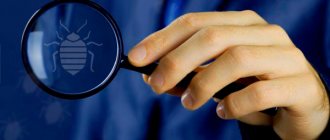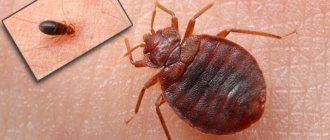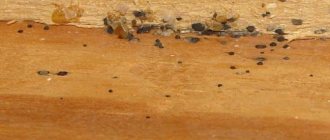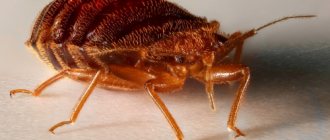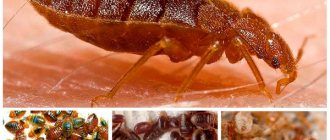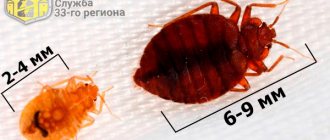Hemiptera (Hemiptera) are a large group of insects with incomplete metamorphosis. This order contains both predatory and herbivorous species. Terrestrial or aquatic insects. Many species of hemiptera are pests of agricultural crops and gardens. They are very different in appearance, color and lifestyle. Hemipterans are common in all parts of the world.
Mexican psyllid (Diaphorina citri)
Structure
The body shape of Coleoptera varies greatly depending on the lifestyle and environment (most often moderately flattened). The head is of very different shape and size, often somewhat retracted into the first segment of the thorax. The antennae are most often setae-like or thread-like, consisting of 3-10 segments. Eyes are either simple or absent altogether, others have only complex ones, some have both. There are two pairs of wings. The front wings of ticks are hard in the main part, and thin and transparent towards the free ends. The hind wings are also thin and membranous. At rest, both the hind and terminal halves of the fore wings fold under the rigid main parts of the latter. The elytra has 3 main parts: the apical (usually transparent), the membrane and 2 leathery parts, separated by an oblique suture - the one lying inside (clavus) and the one lying outwards (larger corium). In most water striders, the elytra turn into uniform leathery ones, not divided into parts. Shortening of the elytra and wings is a very common phenomenon in bedbugs. In water bugs, only the lower wings are often shortened, and the elytra are completely preserved, while in water striders, both wings and elytra are shortened (sometimes very strong).
The legs are three pairs, of different structures: running, grasping, swimming, jumping. They consist of a relatively short trochanter and coxa, longer femurs and tibias, and a terminal part - the tarsus, formed by 1-3 segments. The last segment of the tarsus is usually armed with 1-2 claws. The bedbug's wings are reduced. The mouthparts are piercing-sucking, represented by a segmented proboscis of 3-4 (rarely 1) segments, tucked under the underside of the body; its length is sometimes several times greater than the length of the body. The abdomen consists of 6-9 segments. Of the 3 segments of the thorax, only the anterior one (pronotum) and part of the middle one (scutellum) are visible from above; however, in many water striders the scutellum is covered by the posterior edge of the pronotum. The structure of the apex of the abdomen differs somewhat between males and females. The genitalia (copulatory organs) located on the abdomen of males often provide the main distinguishing characteristics for closely related species.
Leaf-legged bug (Anisoscelis foliaceus)
The male genital segment in water bugs is usually retracted inside the apex of the abdomen, while in water striders it is located at the apex of the abdomen. Inside the genital segment are the penis and paired appendages (parameres). On the chest of some species (true bugs) there are glands that secrete a substance that smells unpleasant.
Many hemiptera can produce sound for communication. The "song" of male cicadas, the loudest of all insects, is produced by the thymbal organs on the underside of the abdomen and is used to attract females. Water bugs of the genus Microvelia (Veliidae) can move at speeds of up to 17 cm/s, that is, twice as fast as they can walk.
Hemipteran nymphs have the basic morphological characteristics of the imago, but the elytra and wings are present in the form of more or less developed wing primordia, which do not touch along the suture and are not clearly separated from the scutellum. On the dorsal side of the abdomen, nymphs usually have one, two or three pairs of openings for scent glands. Eyes are absent in all cases. The tarsi always consist of no more than two segments, and the antennae always consist of no more than four. Nymphs are not capable of flight. The larvae are very similar to adults, but have rudimentary wings.
Bugs are pests of cultivated plants
Among the herbivorous bugs, the most important are pests of cereals, especially wheat and barley, and various bugs: the European bug (Eurygaster integriceps), the Austrian bug (E. austriacus), and the Moorish or black bug (E. maurus).
Turtle bugs manifest themselves as pests of grain crops in Central Asia, Ukraine, Crimea and the Caucasus. In the spring, they fly from wintering grounds to grain fields, where they suck the stems of grain crops, weakening them and causing death. This is where turtles breed. Females lay 70-100 eggs in a clutch, from which larvae emerge after two weeks. Larvae and adult bugs attack the ears en masse, destroying and spoiling the filling grains. The larvae molt 5 times, turning into adults, and then migrate from grain crops to wintering sites - into forests and shelterbelts. In Central Asia, they make regular flights to mountain forests at altitudes of up to 1500 m.
The fight against turtles is carried out in various ways. They are destroyed by spraying the affected fields from aircraft. In early spring, at the wintering sites of turtles, fallen leaves are raked into piles, which are covered with earth on top.
In the fields of spring wheat, bait heaps of leaves and straw are arranged, sprinkling the soil under them with powerful preparations. Chickens are used with great success to kill turtles. They are released both into the turtles' wintering grounds and into the fields, where they peck off huge numbers of bugs. The use of egg-eating insects that lay eggs in turtle eggs is also of great importance.
It should be noted that pests of garden crops are cruciferous bugs (genus Eurydema). They feed on wild and cultivated cruciferous crops, especially damaging cabbage, mustard and rapeseed. These are the rapeseed bug (Eurydema oleracea), the painted bug (E. ornata), etc.
Cruciferous bugs
Cruciferous bugs - 1 (Eurydema), genus of stink bugs, family Pentatomidae. Length 5-10 mm. About 30 species, in Eurasia and North Africa; in Russia - 13 species, everywhere except the Far North. They damage plants of the cruciferous family (for example, mustard, cabbage). Widely known: rapeseed bug (E. oleracea) - in the forest zone of the European part and Western Siberia, mustard (E. ornata) and cabbage bugs (E. ventralis) - in the south of the European part..
Among ground bugs there are many predators that destroy harmful insects and thereby bring great benefits.
Anatomy
The esophagus is long and narrow, the salivary glands are well developed, there is no goiter; the stomach consists of several sections; There are usually 4 Malpighian vessels, but there may be 2 or none at all. The tracheal system is well developed and sometimes has bubbles, spiracles up to 10 pairs (3 on the chest, 7 on the abdomen); in some hemiptera the posterior pair of spiracles opens into long tubes. The genital organs are usually paired and consist of 2, 4, 8 or more tubes or bags; there are usually accessory glands and a seed receptacle, and sometimes (in cicadas) a copulatory bursa. Some hemipterans have vocal apparatuses, they are especially developed in cicadas, which have special cavities that play the role of resonators; Some bedbugs make sounds by rubbing their proboscis against their chest or front legs.
Eurybrachys tomentosa
Bed bug reproduction rate
House bugs are lurking blood-sucking parasites of humans. It is quite difficult to detect their appearance in an apartment in a timely manner. Insects lead a secretive lifestyle, but at the same time actively increase the size of the colony. How quickly do bedbugs reproduce? In favorable conditions, at a temperature of 26-30°, 30-42 days are enough for parasites to transform from an egg into a mature individual. Given the high fertility of females, the number of pests grows exponentially. Entomologists have calculated that one female lays 250-500 eggs during its life.
Mating Features
Bed bugs reproduce by traumatic insemination. A male who has reached sexual maturity pierces the integument of the female's abdomen with a sharp copulatory organ. During fertilization, he holds his partner with his limbs. Aggressive males attack not only adults, but also nymphs. Cases of injury to male parasites and other insects (cockroaches) caught in the path of an excited bug are not uncommon. After the puncture, it releases sperm; it remains in the body of insects for a long period. When the gametes enter the body of a male, they are mixed, preserving the genetic material to the benefit of the species.
In representatives of the species Cimex lectularius, between the 4th and 5th abdominal segments there is a notch on the side leading to the copulatory bursa. But the partner does not always hit this exact place with the needle-like genital organ. The unusual method of reproduction looks dangerous to the life of the female. A wound remains at the puncture site, and pathogenic bacteria enter the body.
Nature provides a compensation mechanism. The female body has a special Berlese organ. This neoplasm plays the role of a seminal receptacle. The seed is stored in it for some time. The tissue contains a large number of immune cells that quickly stop invading bacteria. In 2 hours they cope with any pathogen. A special antibacterial enzyme is produced inside the Berlese organ, which preserves the health of females.
Interesting fact. In 1897, zoologist Ribaga discovered an unknown organ in the stomach of a female house bug. The scientist suggested that it serves to create sounds. Upon further examination, there was a supply of sperm inside. The zoologist discovered Berlese's organ, but incorrectly determined its purpose. Only at the beginning of the 20th century did entomologists learn about the traumatic insemination of bedbugs and draw conclusions about the function of the organ.
The entry of male reproductive cells into the body cavity in an extreme situation helps females survive. In case of prolonged hunger, the supply of gametes is spent not on fertilization, but on nutrition. The body digests them instead of protein from the blood. Sperm enter the reproductive organs along with hemolymph. After the eggs are fertilized, the female begins laying eggs. She attaches it in dark crevices. The process occurs daily, the number of eggs laid ranges from 1 to 12.
Information. Before copulation, the male bug needs to suck blood, the female feeds before laying.
Dimensions
Sizes vary widely from 0.8-1 mm (Ceratocombidae) to 109 mm (Lethocerus grandis). In Europe, one of the smallest species is the tiny corixa (Micronecta minutissima) with a length of 1.5 mm, one of the largest is the rod-shaped ranatra (Ranatra linearis) with a body length of 60-70 mm along with air tubes. In the same family there can be both very small species and “giants”, for example Crypsinus angustatus 3 mm long and Eusthenes hercules 39-42 mm.
How bedbugs reproduce - all about blood-sucking parasites
Blood-sucking parasites cause serious harm to human health. They settle in sleeping places, wall cracks and other parts of the room. Residents of the apartment do not see how bedbugs multiply; they suddenly encounter a large colony of insects that has grown in the immediate vicinity. To prevent infection of the premises, it is necessary to study information about the characteristics of the reproduction of parasites.
Nutrition
Most hemipterans feed on plant foods and specifically the juices of flowering plants, which they suck out with the help of a proboscis; some species feed on the juices of mushrooms and ferns. Predatory species feed mainly on small insects. The mouthparts of these insects are adapted for predation. The lower jaws have serrated stylets that are capable of cutting and abrading the tissues of their prey.
Leafhopper Balclutha punctata
Some species of horseflies lead an exclusively predatory lifestyle, while in others predation is only facultative: the blood of insects serves as additional food, while the main food is plant juices. There are forms that feed on both plant and animal foods. Many predators suck juices from other animals, especially insect larvae; some also suck out the corpses of insects. Finally, some hemiptera are permanent or temporary (bed bugs) parasites. Aquatic bugs (Notonectidae, Nepidae) prey on fish fry and frog tadpoles.
The spread of parasites in the apartment
Experts warn that one adult female is enough to colonize a home with synanthropic blood-sucking parasites. Without information about how bedbugs reproduce, it is not clear that if one parasite appears, how will it produce offspring? Female bedbugs are able to retain sperm throughout their lives, using it in parts to fertilize eggs. After one copulation, they give rise to an entire population without partners.
To actively reproduce, the parasite needs regular blood feeding. A bedbug attacks a person every 2-5 days. Feeding lasts up to 15 minutes, while the female drinks up to 7 ml of blood. She comes out of hiding at night or early in the morning at 3-5 o'clock. The instinct of self-preservation tells parasites when the victim is sleeping and does not pose a threat. After saturation, the insect doubles in size. Having received a high-protein diet, the bug goes into a crevice in the bed or other furniture, where it lays its first eggs. From now on this process will be continuous. Read about the harmfulness of insects in the article “Bed bugs: appearance of blood-sucking bugs, and what harm can they cause to health?”
In the apartment, blood-sucking heat-loving parasites find ideal conditions for life and reproduction. They take root in any room, even with perfect cleanliness. Insects require several conditions:
- favorable temperature in the range of 20-30°;
- the presence of people as a source of food;
- secluded places where arthropods hide during the daytime and place their clutches;
- certain air humidity.
From the first eggs laid, sexually mature females will appear in 1-1.5 months, ready for procreation.
Where to look for adult bedbugs and offspring
Parasites make a kind of nest near the feeding site. You can find it by smell; bedbugs have odorous glands, from which an oily liquid with a sharp, unpleasant aroma is released. In the process of communication, insects send signals to each other by secretions from the glands. Their composition is close to the chemical formula of pheromones. The presence of a colony is also indicated by black dots left on the surface of furniture or walls. These are insect excrement; the more there are, the more numerous the group of parasites.
The most likely areas where insects can be found:
- mattress seams;
- upholstery of upholstered furniture (sofa, armchair);
- behind baseboards, picture frames;
- in the cracks of the walls;
- on the back wall of the cabinets.
The appearance of parasites in an apartment is always unexpected. The first sign of their vital activity is bite marks on people’s bodies. Particular attention should be paid to rashes and wounds in the form of paths in children. Bed bugs often enter homes with old furniture purchased from individuals or in a store. They are brought in in the seams of bags or the folds of clothes from their trips. They can even move into the house through ventilation ducts. At the first signs of infestation in the room, begin fighting parasites. It is better to prevent their reproduction than to fight a large colony.
Lifestyle
The lifestyle of hemipterans is very diverse, they are herbivores, parasites of mammals and birds, mycophages, predators, they live in the webs of spiders and embias, also in water and on its surface; Some species of water strider bugs are even found in the open ocean. They are limited only by their ability to penetrate into wood tissue and parasitize inside a living organism. There are both openly living and hidden living species, i.e. living under stones, under bark, in soil, etc. Underwater predators are the most agile and also the most common insects living under water. All species of the family Termitaphididae live in obligate association with termites. Most female Sternorrhyncha are sedentary or completely sessile, attaching themselves to host plants.
Control measures
Preventive actions
The measures are aimed at preventing the appearance of bedbugs and creating conditions that prevent their development and reproduction:
Extermination activities
Insecticides of various formulations are used to kill bed bugs. Ovicidal insecticides are especially effective. Treatment is carried out only in rooms where insects are found. Simultaneous treatment of all adjacent premises is carried out only in hostels and hotels. [3]
When writing the article, the following sources were also used: [4]
Source
Reproduction and development
Among aphids, viviparity, parthenogenesis (also characteristic of mealybugs), polymorphism and heterogony are widespread. In most species, development occurs with incomplete transformation. The intermediate stage between egg and adult is called nymph. Eggs of bed bugs are laid singly or in groups, glued to stems or leaves, and sometimes buried inside plant stems or, in rare cases, in damp sand. After 2-3 molts, the larvae receive the rudiments of wings (pupa or nymph stage) and with a new molt they turn into an adult insect.
Laceweed (Corythucha sp.)
Maliciousness
The bedbug is a blood-feeding synanthrope that is closely associated with human habitation. One of the first species to undergo synanthropization at the dawn of humanity and change its host from a bat to a human. [5]
The pest feeds on blood, attacking humans, various animals and birds. It feeds in the larval and adult stages. It causes anxiety to people, interferes with sleep, thereby reducing their performance. Causative agents of various infections (plague, typhus and relapsing fever, tularemia, Q fever) have been found in the body of the bug, but there is currently no accurate data on the transmission of infections to humans. [3]
What prevents reproduction
Females and males reproduce quickly only in a comfortable environment. When unfavorable conditions arise, insects slow down the rate of population increase.
Temperature
The optimal temperature for the development and life of an insect is +25…+30°C. Until the ambient temperature drops to +10°C, bedbugs will continue to reproduce, but at a slower rate.
This process stops completely when suspended animation occurs, i.e. when the ambient temperature drops to +5°C and below. Frost from -10°C is fatal for bed bugs.
Humidity
Bed bugs feel most comfortable in warm and dry rooms. Parasites cannot tolerate high humidity; the optimal indicators for them are 40-60%. Low humidity is easily tolerated by adult insects; they replenish the lack of fluid by increasing the amount of blood they consume.
The eggs run the risk of dying, because if there is a lack of environmental humidity, they quickly dry out and the embryo dies. If the humidity is too high (70% or higher), the eggs are susceptible to fungal infections.
Lack of food
A bedbug can live without blood for 3-4 days, a larva - 2-3 days. But even a month of hunger strike does not lead to the death of the bed parasite. If the insect does not receive food within 14-16 days, it will fall into a “inhibited” state - suspended animation. In this state, all processes in the body slow down, and nutrient consumption is reduced to a minimum.
Important! With the lack of food, the ability to reproduce offspring stops.
Anabiosis
Anabiosis is the next stage of “slowing down” the life activity of the bug. This state occurs at a temperature of 0…+5°C. Too high a temperature does not lead to suspended animation, it kills the insect. The larva dies at +45°C, the adult bug lasts up to +70°C.
In this state, the parasite stops moving, feeding and reproducing.
Home bug habitats
In order to fight bloodsuckers, you need to study its habitats.
- Bed - mattresses, pillows, blanket. Bed frame, assembly points.
- Bedside rugs, bedside tables, chest of drawers. Rear wall of furniture, pull-out shelves.
- Paintings, carpets and wall decorations.
- Wardrobes for storing clothes, places under window sills and behind heating panels.
- Upholstered furniture - there are a lot of loopholes, seams, folds, mechanisms.
- Cracks in furniture, floors and behind baseboards.




